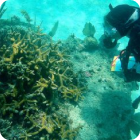For immediate release: November 22, 2016
Media contact: Andrew Walker, Foundation President & CEO, 941 809-7805 or [email protected]
Photos available
Florida Endangered Species Plan Approved
“Our charismatic species get a lot of attention, but the animals covered by this Imperiled Species Management Plan need attention too,” said Commissioner Chuck Roberts. “All of these species are very important to long-term resource management here in Florida.”
After adopting a new conservation model in 2010 that requires a management plan for imperiled species, the FWC embarked upon a process of collaboration with stakeholders and the public. Three drafts of the plan were presented for review, generating hundreds of comments on each draft, and leading to changes in the plan. Experts from outside the FWC also participated in Biological Status Reviews that evaluated which fish and wildlife species should be designated as imperiled.
“The Imperiled Species Management Plan addresses a diversity of imperiled species, from the reddish egret to the Florida bog frog, Barbour’s map turtle and bluenose shiner,” said Brad Gruver, who leads the agency’s Species Conservation Planning section. “In the past, we successfully used management plans for individual species like the bald eagle and manatee. With this plan, we take into account what imperiled species have in common, such as the need for us to improve what we know about them and to better coordinate how we manage multiple species.”
While the biologists who developed this 10-year plan are responsible for its implementation, the public is encouraged to step into key roles. Citizen-scientists can volunteer to help survey wildlife and collect data. Private landowners can conserve imperiled species on their property. Schools, businesses, organizations and individuals can become informal educators on imperiled wildlife.
“We have been involved in the effort to revise Florida’s imperiled species listing process and management system since the very beginning,” said Elizabeth Fleming, Senior Florida Representative, Defenders of Wildlife. “We are extremely pleased to see the adoption of a comprehensive imperiled species management plan and associated rules. Now the important work of implementing these important conservation measures can begin.”
Important things to know about the Imperiled Species Management Plan:
- It includes one-page summaries for each species, including a map of its range in Florida and online links to Species Action Plans. The 49 Species Action Plans contain specific conservation goals, objectives and actions for all 57 imperiled species.
- It also has Integrated Conservation Strategies that benefit multiple species and their habitats, and focus implementation of the plan on areas and issues that yield the greatest conservation benefit for the greatest number of species.
- It highlights conservation success with 15 species that are being removed from the list of imperiled species but are still being monitored and conserved under the plan.
What are the 57 fish and wildlife species in the plan?
- Eight mammals: Big Cypress fox squirrel, eastern chipmunk*, Everglades mink, Florida mouse*, Homosassa shrew, Sanibel rice rat, Sherman’s fox squirrel and Sherman’s short-tailed shrew.
- Twenty-one birds: American oystercatcher, black skimmer, brown pelican*, Florida burrowing owl, Florida sandhill crane, least tern, limpkin*, little blue heron, Marian’s marsh wren, osprey (Monroe County population), reddish egret, roseate spoonbill, Scott’s seaside sparrow, snowy egret*, snowy plover, southeastern American kestrel, tricolored heron, Wakulla seaside sparrow, white ibis*, white-crowned pigeon and Worthington’s marsh wren.
- Twelve reptiles: alligator snapping turtle, Barbour’s map turtle, Florida brown snake (Lower Keys population), Florida Keys mole skink, Florida pine snake, Key ringneck snake, peninsula ribbon snake* (Lower Keys population), red rat snake* (Lower Keys population), rim rock crowned snake, short-tailed snake, striped mud turtle* (Lower Keys population) and Suwannee cooter*.
- Four amphibians: Florida bog frog, Georgia blind salamander; gopher frog* and Pine Barrens treefrog*.
- Nine fish: blackmouth shiner, bluenose shiner, crystal darter, harlequin darter, Lake Eustis pupfish*, key silverside, mangrove rivulus*, saltmarsh topminnow and southeastern tessellated darter.
- Three invertebrates: Black Creek crayfish, Florida tree snail* and Santa Fe crayfish.
As to the listing status of all the plan’s 57 species, 14 were listed as state Threatened prior to the plan and will remain listed as state Threatened; 23 will change listing from Species of Special Concern to state Threatened; five will remain Species of Special Concern; and 15 will be removed from the imperiled species list (* indicates a species coming off the imperiled list but still being conserved).
Rule changes associated with implementing the plan are anticipated to take effect in December 2016.
About the Fish & Wildlife Foundation of Florida
The Fish & Wildlife Foundation of Florida is a nonprofit organization dedicated to supporting the Florida Fish and Wildlife Conservation Commission and many other public and private partners to conserve Florida’s outstanding fish and wildlife resources and the lands and waters they need to survive. More information can be found at FishWildlifeflorida.org.













